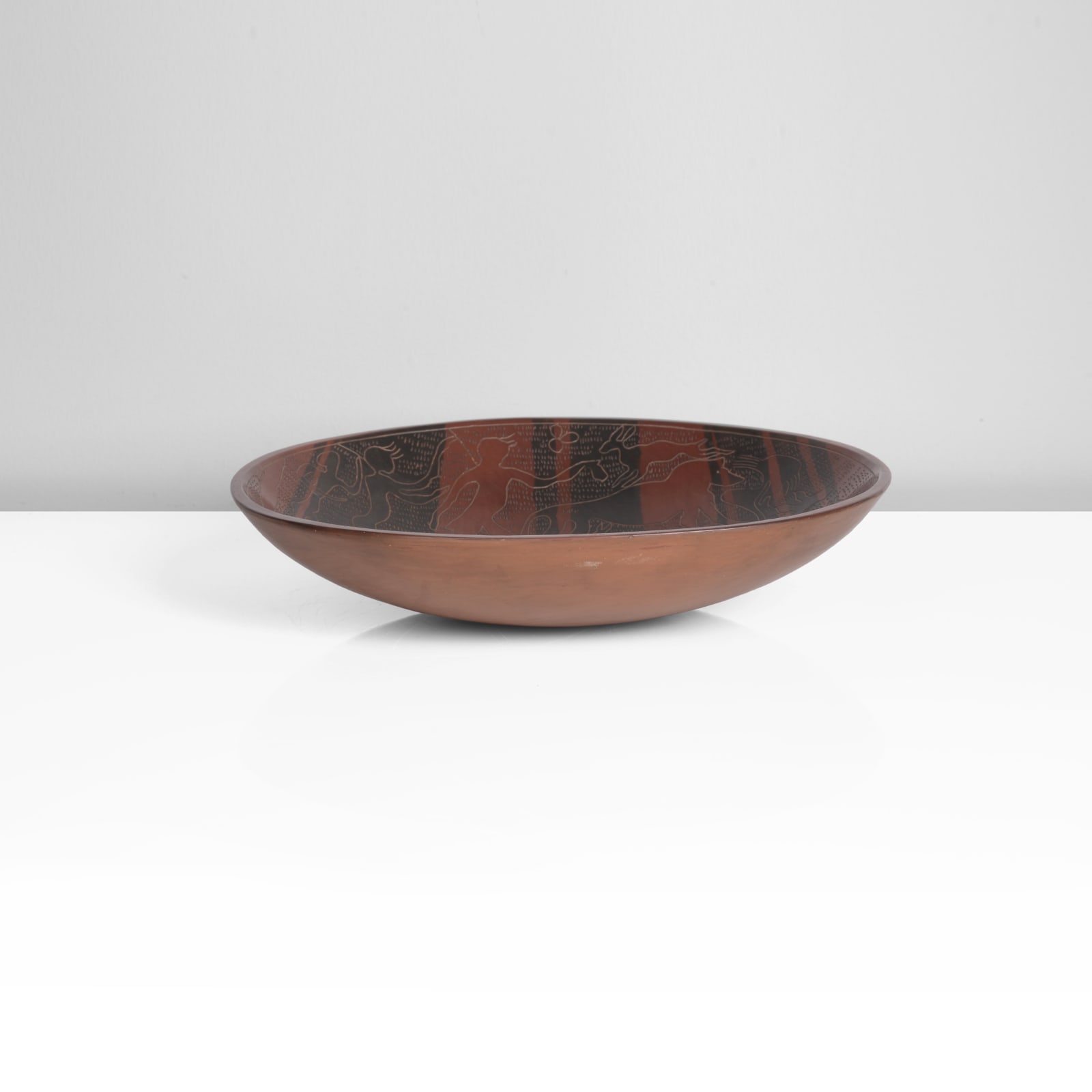Siddig el Nigoumi
Further images
Provenance
Dr Anne-Carole Chamier CollectionAcquired from CPA Gallery, London 'Four from Farnham', Sep - Oct 1983, list no.74
Siddig Abdelrahman Talha El Nigoumi was born in 1931 in Hamadi a village south of Kassala in east Sudan and came from an old powerful family. As a child he would play near the White Nile river and model things out of river clay. Between 1952-1955 he attended the Khartoum School of Art and inspired by Osman Abdullah Wagiallah became his student and trained as a master calligrapher. But he increasingly concentrated on ceramics. He was introduced by British teachers to the European ceramic techniques. He was intrigued and learned to prepare clay, to throw and turn pots on a wheel, to use stoneware and glazes. Quickly Nigoumi started implementing traditional African techniques favouring the European machines for more simpler African techniques fusing the two worlds and creating his own unique style. Nigoumi went on to become a student teacher at the art school for a few year. After Sudans independence in 1956, Nigoumi along with Ahmad Shibrain (1930-2017) won scholarships in 1957 to the Central School of Arts and Crafts in London. They weren’t the only artist from Sudan that made their way to the UK on a scholarship. Nigoumi followed Ibrahim el Salahi and Kamala Ibrahim Ishaq came a few years later to study at the Royal College of Art giving rise to a group of artists called the Khartoum School. The Khartoum School was a movement of visual artists who cultivated a new visual style called Sudanawiyya, which expressed local and Pan-African traditions alongside Western influences. Through the use of calligraphy, the easthetics of hurufiyya (trandforming Arabic letters into abstract shapes; named after harf the Arabic word for letter) and Islamic motifs, the movement attempted to convey the cultural fabric of Sudan. After his time in London Nigoumi retuned to Khartoum with his wife the artists and textile designer Eileen Vickery. He was made the deputy head of the ceramics department. He encouraged his students to draw inspiration from their own culture. Even though he was sympathetic to the British art and culture, he felt that the ceramic curriculum taught at the school remained far too dominated by British traditions. During the 1960’s things politically started to change in Sudan and Nigoumi and Eileen decided to leave with their 3 childeren and return to England in 1967. He found a job as a technician of ceramics at the Farnham school of Art in Surrey. At the time the pottery department under the leadership of Henry Hammond and Paul Barron was one of very best in the country. Nigoumi went on to become a lecturer and taught widely and was sought out by international students throughout his career. His former student and friend Magdalene Odundo, OBE (b. 1950) admired his work and teachings not only because they shared many points of cultural outlook, their countries sharing a border but for both their heritage was an important influence on their practice.
Besides his work for the school and his teachings Nigoumi kept producing work and developing a distinct personal style. After experimenting with glazing in the seventies and even developing his own glaze, in the eighties he began to work more frequently in earthenware. He decorated the surfaces with a thin slip into which he drew sliptrailed or using a knitting needle, incised lines after which he then burnished the surfaces with an old teaspoon or a stone. Traditionally in Sudan this was preferably done with a smooth hand sized shell from the Red Sea. After which they are fired on an open fire made of sticks, brushwood and dung for a few hours. Nigoumi used an electric kiln but after he would smoke fire the surface using rolled up newspaper. His love for the traditional domestic Sudanese earthenware was at the core of his practices. Inspiration for his decorations came from images from his memories in Sudan and from books, newspapers and magazines around him. His notebooks were filled with elaborate pencil drawings of symbols, patterns and motifs that interested him.
Our oval earthenware dish Cave Drawings with bands of dark and lighter brown slip has an intricate design of figures and animals engraved on its surface. Placed on a background pattern of a carefully engraved small incisions which could represent grassland. Some of the figures are easily recognisable human forms with elegant, elongated legs others look more like mystical creatures from an ancient legend like the two figures that resemble Anubis in the bottom centre of the dish and the hybrid animals scattered around the surface. The title would have us think that Nigoumi was inspired by the ancient Nubian cave drawings found in archaeological site Sabu-Jaddi north of Khartoum. A little symbol that appears in all his works can be found on the bottom left. It’s a miniature scorpion a reminder of the Sudanese desert, it is said to bring good luck.







